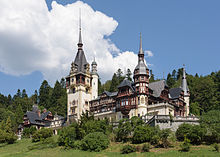Peles Castle
Peleș Castle is located around 1.5 kilometers northwest of the city of Sinaia in Romania . Pelișor Castle is about 300 meters up the slope .
history
The castle was built between 1873 and 1883 for King Carol I of Romania. The client commissioned the Viennese architect Carl Wilhelm Christian Ritter von Doderer(* 1825, † 1900) with the castle planning. After 1876, Doderer's assistant architect Johannes Schultz took over the further construction work and changed the original plans. The official inauguration of the castle took place on October 7, 1883. The Czech architect Karel Liman was commissioned to carry out further construction work, including the construction of the main tower, between 1893 and 1914. The castle served as his summer residence until Carol's death in 1914. After the abolition of the monarchy and the transformation of Romania into a people's republic in 1947, the communist regime confiscated the castle.
After the Romanian Revolution in 1989 , the Peleș and Pelișor castles were returned to the ex-King Michael , who was in exile in Switzerland .
For the 2008 film Brothers Bloom , some scenes were shot at the castle. In one scene, the lock was blown up using visual effects . In 2011 the castle served as the backdrop for the film A Princess for Christmas with Roger Moore in the lead role. The 2017 Netflix production A Christmas Prince also had the castle as a backdrop.
Furnishing
The bay and the half-timbered walls of the castle remind both the Romanian kuk -time (Sinaia, however, has never been one of Austria-Hungary) and to the Hohenzollern Castle , the home of the king. Seven terraces surround the castle. Some of the 160 rooms can now be visited. The castle museum has a collection of weapons, sculptures, furniture and decorative objects from the 15th to the 19th centuries as well as an orchestrion by M. Welte & Sons . It also includes a 60-seat theater that was later converted into a cinema. Gustav Klimt was commissioned with the murals . Since the castle is particularly impressive because of its woodwork, it was equipped with central heating to avoid open fires. This was initially fired with wood, but switched to gas after the Second World War. It is equipped with 2 elevators and a central vacuum cleaner system with 4 exits. Right from the start there was also running warm water, a telephone connection and electrical lighting. After Carol's death, his wife, Queen Elisabeth zu Wied , made no further changes to the castle. She even left her music room unfinished.
literature
- Léo Bachelin: Castel Pelesch. Residence d'été du roi Charles Ier de Roumaine à Sinaia . Firmin-Didot, Paris 1893.
- Ruxanda Beldiman: Castelul Peleș. Expresie a fenomenuluiistoristde influență germană . Simetria, Bucharest 2011, ISBN 978-973-1872-22-3 .
- Virginia Christu (Hrag.): Peleș Castle . Sinaia 1972 (illustrated book)
- Jakob von Falke (ed.): The Romanian royal castle Pelesch . Gerold, Vienna 1893.
- Hans Jakob Wörner : Sinaia-Peles. The residence of the Hohenzollern in Romania . In: Florian Fiedler (ed.): The castle and its equipment as a monument preservation task . Lipp, Munich 1995, ISBN 3-87490-628-0 , pp. 52-57.
Web links
- Official homepage (Romanian / English)
Individual evidence
- ↑ Alex Zamm Films: A Christmas Prince. Moviejones GbR, accessed November 26, 2017 .
Coordinates: 45 ° 21 '36 " N , 25 ° 32' 34" E

